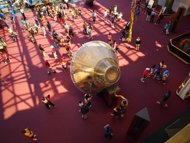Apollo 11 capsule stirs Neil Armstrong memories, tributes

He snapped a photo of the spacecraft with his smartphone, then immediately posted the digital image onto his Facebook account for his hundreds of friends around the world to see.
It was his way, he said, of paying tribute to the first man to walk on the moon.
"This is the first time it really hit home, thinking about Neil Armstrong," who died Saturday at the age of 82, said Hehman, 29, a sales executive and Chicago native now living in Sydney, Australia.
"You always have this image in your mind of the module itself," he added after peering into the Plexiglas-enclosed artifact, "but you never actually get to see the inside and the buttons and things."
Columbia, the official name of the Apollo module in which Armstrong and fellow astronauts Buzz Aldrin and Michael Collins made their historic voyage in July 1969, enjoys pride of place in the foyer of the museum in Washington.
It rubs shoulders with Friendship 7, in which John Glenn orbited Earth three times in February 1962, and Gemini IV, from which Edward White conducted the first American space walk in June 1965.
Inside a small pedestal is a smooth black chunk of moon rock that you can touch. From the rafters hangs the Spirit of Saint Louis, in which Charles Lindbergh made the first non-stop solo flight across the Atlantic in May 1927.
The famously private Armstrong became a global hero on July 20, 1969 when he set foot on the moon with the immortal phrase: "That's one small step for man, one giant leap for mankind."
On Monday, US President Barack Obama ordered all official US flags to be flown at half mast on Friday, when Armstrong's family has scheduled a private funeral in his native state of Ohio.
Under a longstanding agreement with the National Aeronautics and Space Administration (NASA), the Smithsonian has first dibs on any object from the US space program that it deems to be historic.
The Apollo 11 module -- with three-aside seating and tiny windows -- reached the Smithsonian in 1970 after a rivet-by-rivet inspection by NASA engineers in Houston, Texas and a triumphant 50-state tour of the nation.
"The original (Saturn) rocket that went up (into space) was about the size of the Washington Monument," Allan Needell, curator of the Apollo program at the Smithsonian, told AFP alongside the Apollo 11 module in reference to an architectural landmark in the US capital.
"And this is all that came back, with the three astronauts on board."
Also on exhibit is a landing craft like the one Armstrong and Aldrin rode down onto the lunar surface, and an Apollo instrument panel with a baffling array of switches and far less computing power than today's basic cellphones.
"I love this stuff. It's so fascinating," said physician David Desimone, 62, from Lexington, Massachusetts, who recalled "very vividly" sitting with his family, watching live images of Armstrong and Aldrin walking on the moon.
"It was the event of the century," he told AFP.
Looking into the Apollo 11 module, his 20-year-old daughter Katherine Desimone, a university economics student, couldn't help but wonder how three grown men could bear such a confined space for so long.
"I cannot imagine ever going into something like this, ever," she said, laughing. "They're lying down? Three people next to each other? Going into space? It's like the most ridiculous thing ever -- but it's so cool."
Needell, who joined the Smithsonian in 1984, met Armstrong several times.
"He was never the chatty guy," he recalled. "He bragged that he was always a pocket-protector engineer -- the kind that we would call nerds today. It was something he took great pride in."
What the stars mean:
★ Poor ★ ★ Promising ★★★ Good ★★★★ Very good ★★★★★ Exceptional
 Tag:
Tag:
Related Contents
Latest News
More News
- Tropical storm Trami leaves at least 24 people dead in Philippines (October 24, 2024 | 17:36)
- Singapore grants conditional approval for solar power import from Australia (October 24, 2024 | 17:27)
- ASEAN digital economy set to reach $2 trillion by 2030 (October 22, 2024 | 15:08)
- Thailand asks Laos to waive visa fee at border checkpoints to boost tourism (October 21, 2024 | 17:23)
- Laos pledges to continue efforts to empower girls (October 21, 2024 | 17:17)
- Chinese electric vehicle maker to build plant in Indonesia (October 21, 2024 | 17:12)
- Vietnam Elevator Association introduces Elevator Safety Application to the world (October 18, 2024 | 09:00)
- A taste of the future - the go-to spot at the Worldchefs Congress & Expo 2024 (October 15, 2024 | 16:11)
- Jakarta to impose household waste levy (October 14, 2024 | 16:49)
- China, Laos plan to build connectivity development corridor with Thailand (October 14, 2024 | 16:19)
























 Mobile Version
Mobile Version